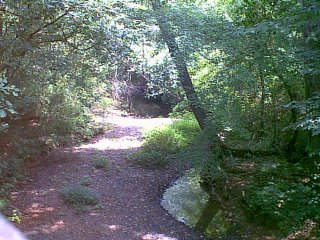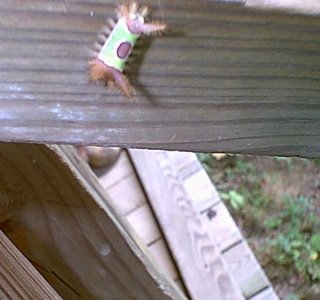
48 counties in Alabama and several counties in Georgia were declared natural
disaster areas in June because of the drought. By the end of August, the
Environmental Protection Division had issued a level one drought declaration
for the entire state, and several other southern states were declared in various
stages of drought conditions. Restricted water use, farmers eligible for
emergency loans. Record temperatures and little rain. Farmers and ranchers
in the plains states were talking about the 1930's dust bowl. Now, as then,
stunted corn stalks rattled in the fields, water holes were gone, and large herds
of cattle were sold off to save them from starvation.
Cane Creek is drying up. The music of running water is stilled. Long stretches
of rock and sand with only an occasional pool of water. It was like this four
years ago, but there were more and larger pools of water then. This is the
worst I've ever seen here. There were a few good rains in August; 24 hours
after the rain ended the ground would be dry, and I would be carrying water
to my little garden and small herb patch.
There is still a stretch of shallow water bordering my yard, but it was divided
into two parts in August, and now in September into three, with rocky barriers
between. One day in August as the water receded, I was in the back yard
when I heard a loud slapping sound. A fish had somehow flipped from the
water onto the dividing rocks. I wouldn't have believed that a fish no larger
than my hand could thrash about so vigorously and make so much noise. I
saved it by flipping it back into the water with a stick. But that fish and many
more will die as the drought continues. They are slowly being deprived of
oxygen, and they normally depend on bugs and debris washed in along with
run off from the rain for some of their food.
Four years ago, as the water sank lower and lower, big suckers over a
foot long lay gasping and dying in the shallows. I've seen no suckers that big
since, and now I'm not seeing even hand-size fish. The shallow stretch of
water along my back yard is covered with an ugly scum.
Buckie and I went walking in the dry creek bed, as we did four years ago.
It's the only time we can safely walk long distances through here during the
summer. We can see there are no snakes underfoot on this strange, rough
road.My walking stick was provided by the beavers. There were always
limbs and sticks floating down the creek, each neatly cut at an angle, peeled
clean of bark. I saved those that were straight and sturdy and of a comfortable
length.
The beavers have long been gone. Buckie ran about sniffing their caves.
I wished I'd brought along a flashlight so I could see how far they'd dug into
the creek bank. Only once have I seen the creek ice over, and then the ice
only lasted a couple of days, so they do not need to build winter lodges and
stockpile food as they do in the northern ponds.

Trees at the creek's edge sent their roots down through the water into the
bottom of the creek bed. Now these roots are exposed, gnarled and twisted.
Behind these roots are the beavers' caves. The odd lacework of roots reminds
me of burglar guards across a storefront. They wouldn't provide the beavers as
much protection as a burglar guard against their enemies, dogs and men, but
perhaps they made them feel more secure.
I wonder where the beavers are, and if they've even survived. I'd think they
would have headed for the nearest water, the Chattooga River, about 7 miles
away. It's still running, though very low. Bevers move clumsily on land.
They would have had to cross highways and fields near houses with dogs.
And the Chattooga River is polluted. The textile factory in the next town
has been fined several times by the EPA for releasing dyes and other wastes
into the river.
In one pool we pass, at least a dozen crayfish dart about. I usually only see
crayfish at night when I stand on the back deck and shine a light into the
water, catching them by surprise before they scuttle backward into the sand.
Also concealed in the sandy bottom in normal times are the mussels. I've
yet to see a live one, but I've often seen their shells, left by some creature
that savours their flesh. Now the empty shells are strewn through the rocks,
many so tiny they seem not worth the effort to open for the tiny morsel within.
Mussels don't seem to grow very large in this creek, the largest shell I've
seen is about 2 1/2-inches long. The shell linings that look like mother-of-pearl
are not as thick and lustrous as in the much larger shells I've taken from the
Tennessee River.
The bits of color in the woods to either side were leaves, gold and bronze
and crimson, turned and fallen two months before their time. Trees were
dying. Dead limbs littered the creek bed.
My attention was drawn to a pile of what looked at first to be rat droppings.
Poking them about with a stick, I discovered they were periwinkle shells, dusty
from dried mud, for they, too, spend much of their time buried, trying to stay
safe from predators. But one must have crouched here, sucking out their flesh
and then tossing the shells into this neat pile.
As to what feasted on the mussels and periwinkles, I can only guess.
Raccoons? Opossums? Or do coyotes roam the woods here, about two miles
north of my house. And I once saw a pair of muskrats swimming down the
creek at night. They were terrified of my light and swam quickly away to
hide. They could also have a taste for shellfish.
Walking down this rocky bed, I've never seen any Indian tools or artifacts.
Most of the rocks are dark and dull, indicating some iron content, or they
are sandstone, not the kind of stone for making arrowheads or tools. And
why should the Cherokees have camped long beside this creek, so
insignificant compared to other bodies of water not so far from here, the
Chickamauga Creek, the Tennessee River, and even the Chattooga River
when it ran clean and pure. And they did not always camp beside creeks
and rivers. I know of fields far from large bodies of water where spring
plowing never failed to turn up a few arrowheads and an occasional stone
tool. At least this was true several years ago.
Even though wading the occasional pool alleviated the heat, it was still too
hot for walking before late afternoon in August, so we could only wander
for about three miles or so up the creek before turning back if we were to
get home before dark.
Another afternoon I had planned to clean the kitchen, but the forecast was
for rain the next day. I thought it could be the first rain of many and the creek
would fill up again. It was four years ago when the creek dried up, and would
it be four years again before I could walk that rocky bed? And would I, when
four years older, be able to walk it?
I set the broom aside and pulled on my creek shoes. The rippled soles help me
to navigate the rocks, and the mesh tops drain out the water after I've waded.
This time we went down the creek, ending up within sight of a house, the first
one visible from the creek during our walks. Children were calling to one
another and someone had started a fire, I suppose for a cookout. The house
was some distance from the creek, but I felt like a trespasser, and we had
traveled our three miles or so.
Shortly before the house there is an underground stream that surfaces just
below the creek bank, filling the creek bed with cold, clear water. It was
only a few inches deep, but felt so good to my feet, cooling and refreshing
me. The evening air was thick with humidity from the impending rain.
Then the dry, rocky stretches all the way home. Here, as up the creek,
I was struck by the silent tragedy of countless deaths. All the tadpoles that
would never become frogs to serenade the summer evenings. There was
never a trace of the fish or the smaller water creatures such as the caddisflies.
The birds and the woods creatures must have feasted.
The polar ice cap is melting and polar bears are losing their homes. Here the
water world had vanished, and how would it affect the surrounding area.
Do not ask for whom the bell tolls..
It was getting dark. We had started out later than usual. Only an occasional
faint star shone through the clouds and there was no moon to light our way.
I was glad when the bridge suddenly loomed a few feet ahead, for under the
bridge and we would be beside our front yard and home.
After walking on sand and rocks, my feet felt as if they had been massaged.
I slept deeply that night and dreamed of running water where fish leaped
silvery in bright sunlight. That dream would be shattered many times in
the following days when I walked the dry creek bed again.
I started writing this in August. By the third week of September, although
we had rain and no longer had the blasting heat that dries up the rain soon
after it falls, the pools of water were noticeably smaller. There was no water
under the bridge. The creek bed had been dry at least a month longer than
it was four years ago. Then at last, during the fourth weekend of September
rain poured down and by Sunday afternoon the creek was filled with muddy,
flowing water. There is again the music of water rippling over rocks and
cascading over the edges of one rocky island that remains. We again have a
creek. The water will become clear in a few days and I will be wading again,
especially after a hot afternoon of yard work or grass cutting. There were
beavers in the creek again after the last drought. I wonder if they or some
of their offspring will come back this time.
